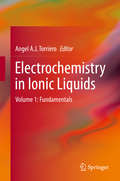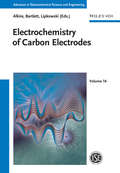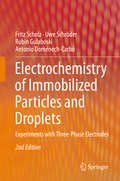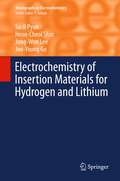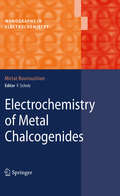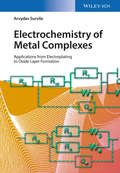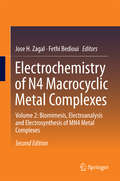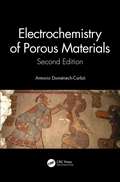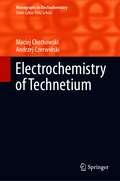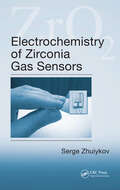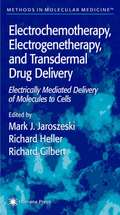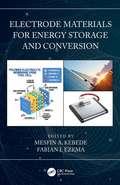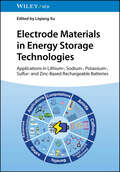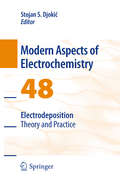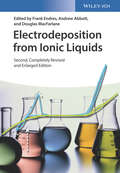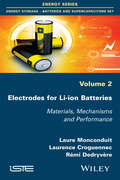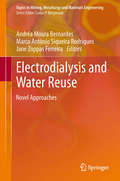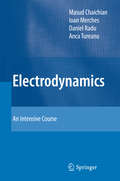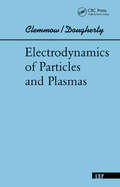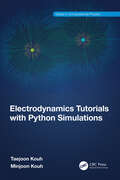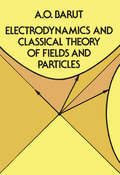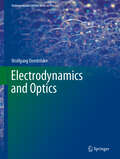- Table View
- List View
Electrochemistry in Ionic Liquids
by Angel A. J. TorrieroThis is a set of two books dedicated to presenting the latest novel and advanced research from around the world in this exciting area. These books highlight the important properties of electrochemistry in ionic liquids - as opposed to the more commonly used aqueous and organic environments - and the many applications. Readers will find 20 chapters gathered in two books : Electrochemistry in Ionic Liquids - Volume 1, Fundamentals: This book critically discusses electrode-electrolyte interfacial processes, reference electrodes, ultramicroelectrode voltammetry and scanning electrochemical microscopy, semi-integral and convolution voltammetry, and small-angle X-ray scattering coupled with voltammetry. The structure and properties of protic ionic liquids, deep-eutectic solvents, task-specific ionic liquids, polymeric ion gels, and lithium-ion solvation, useful for electrochemical application is also critically discussed. Electrochemistry in Ionic Liquids - Volume 2, Applications: The major topics covered in this book include electrodeposition and electroless deposition, voltammetry of adhered microparticles, electrochemistry of organic and organometallic compounds, electrocatalytic reactions, oxygen reduction reaction, ionic liquids in surface protection and lubrication, current industrial application of ionic liquids, and challenges, issues and recycling methods of ionic liquids in industrial developments.
Electrochemistry of Carbon Electrodes
by Richard C. Alkire Jacek Lipkowski Philip N. BartlettThe book sets the standard on carbon materials for electrode design. For the first time, the leading experts in this field summarize the preparation techniques and specific characteristics together with established and potential applications of the different types of carbon-based electrodes. An introductory chapter on the properties of carbon together with chapters on the electrochemical characteristics and properties of the different modifications of carbon such as carbon nanotubes, graphene, carbon fiber, diamond or highly ordered pyrolytic graphite provide the reader with the basics on this fascinating and ubiquitous electrode material. Cutting-edge technologies such as carbon electrodes in efficient supercapacitors, Li-ion batteries and fuel cells, or electrodes prepared by screen-printing are discussed, giving a complete but concise overview about the topic. The clearly structured book helps newcomers to grasp easily the principles of carbon-based electrodes, while researchers in fundamental and applied electrochemistry will find new ideas for further research on related key technologies.
Electrochemistry of Immobilized Particles and Droplets
by Fritz Scholz Uwe Schröder Rubin Gulaboski Antonio Doménech-CarbóThis second edition of a successful and highly-accessed monograph has been extended by more than 100 pages. It includes an enlarged coverage of applications for materials characterization and analysis. Also a more detailed description of strategies for determining free energies of ion transfer between miscible liquids is provided. This is now possible with a "third-phase strategy" which the authors explain from theoretical and practical points of view. The book is still the only one detailing strategies for solid state electroanalysis. It also features the specific potential of the techniques to use immobilized particles (for studies of solid materials) and of immobilized droplets of immiscible liquids for the purpose of studying the three-phase electrochemistry of these liquids. This also includes studies of ion transfer between aqueous and immiscible non-aqueous liquids. The bibliography of all published papers in this field of research has been expanded from 318 to now 444 references in this second edition. Not only are pertinent references provided at the end of each chapter, but the complete list of the cited literature is also offered as a separate chapter for easy reference.
Electrochemistry of Insertion Materials for Hydrogen and Lithium
by Joo-Young Go Su-Il Pyun Jong-Won Lee Heon-Cheol ShinThe understanding of hydrogen/lithium insertion phenomena is of great importance for the development of the next generation of functional electrochemical devices such as rechargeable batteries, electrochromic devices, and fuel cells. This volume introduces a variety of viable electrochemical methods to identify reaction mechanisms and evaluate relevant kinetic properties of insertion electrodes. The authors also outline various ways to analyze anomalous behaviour of hydrogen/lithium transport through insertion electrodes.
Electrochemistry of Metal Chalcogenides
by Mirtat BouroushianThe author provides a unified account of the electrochemical material science of metal chalcogenide (MCh) compounds and alloys with regard to their synthesis, processing and applications. Starting with the chemical fundamentals of the chalcogens and their major compounds, the initial part of the book includes a systematic description of the MCh solids on the basis of the Periodic Table in terms of their structures and key properties. This is followed by a general discussion on the electrochemistry of chalcogen species, and the principles underlying the electrochemical formation of inorganic compounds/alloys. The core of the book offers an insight into available experimental results and inferences regarding the electrochemical preparation and microstructural control of conventional and novel MCh structures. It also aims to survey their photoelectrochemistry, both from a material-oriented point of view and as connected to specific processes such as photocatalysis and solar energy conversion. Finally, the book illustrates the relevance of MCh materials to various applications of electrochemical interest such as (electro)catalysis in fuel cells, energy storage with intercalation electrodes, and ion sensing.
Electrochemistry of Metal Complexes
by Arvydas SurvilaA systematic analysis of electrochemical processes involving metal complexes. Starting with general considerations on equilibria in solutions and at interfaces as well as on mass transport, the text acquaints readers with the theory and common experimental practice for studying electrochemical reactions of metals complexes. The core part of the book deals with all important aspects of electroplating, including a systematic discussion of co-deposition of metals and formation of alloys. It also discusses such related subjects as oxide layer formation and hydrogen evolution as a side reaction.
Electrochemistry of N4 Macrocyclic Metal Complexes
by Jose H. Zagal Fethi BediouiThisnew edition describes the state of the art regarding molecular catalysts suchas MN4 metal complexes, like porphyrins and phthalocyanines. This volumefocuses on the particular case of the electrocatalysis of the reduction of O2for practical applications in fuel cells and air batteries. Indeed, active andstable materials have been developed in the last 5 years where MN4 catalyticsystems can be obtained by the pyrolysis of starting materials that do notnecessarily involve MN4 complexes. These latter systems constitute a new classof stable and highly active non-precious metal catalysts for ORR that canreplace expensive Platinum containing electrodes. The book also offersfuture projections and points out new fields of research and developmentof these non-precious metal catalysts.
Electrochemistry of Porous Materials
by Antonio Doménech CarbóElectrochemistry of Porous Materials describes essential theoretical aspects of the electrochemistry of nanostructured materials and primary applications, incorporating the advances in the field in the last ten years including recent theoretical formulations and the incorporation of novel materials. Concentrating on nanostructured micro- and mesoporous materials, the highly anticipated Second Edition offers a more focused and practical analysis of key porous materials considered relatively homogeneous from an electrochemical point of view. The author details the use of electrochemical methods in materials science for characterization and their applications in the fields of analysis, energy production and storage, environmental remediation, and the biomedical arena. Additional features include: Incorporates new theoretical advances in the voltammetry of porous materials and multiphase porous electrochemistry. Includes new developments in sensing, energy production and storage, degradation of pollutants, desalination and drug release. Describes redox processes for different porous materials, assessing their electrochemical applications. Written at an accessible and understandable level for researchers and graduate students working in the field of material chemistry. Selective and streamlined, Electrochemistry of Porous Materials, Second Edition culls a wide range of relevant and practically useful material from the extensive literature on the subject, making it an invaluable reference for readers of all levels of understanding.
Electrochemistry of Technetium (Monographs in Electrochemistry)
by Maciej Chotkowski Andrzej CzerwińskiThis book provides detailed information on the electrochemistry of technetium compounds. After a brief physico-chemical characterization of this element, it presents the comparative chemistry of technetium, manganese and rhenium. Particular attention is paid to the stability, disproportionation, comproportionation, hydrolysis and polymerization reactions of technetium ions and their influence on the observed redox systems. The electrochemical properties of both inorganic as well as organic technetium species in aqueous and non-aqueous solutions are also discussed. The respective chapters cover the whole spectrum of topics related to the application of technetium in nuclear medicine, electrochemistry of technetium in spent nuclear fuel (including corrosion properties of technetium alloys), and detecting trace amounts of technetium with the aid of electrochemical methods. Providing readers with information not easily obtained in any other single source, the book will appeal to researchers working in nuclear chemistry, nuclear medicine or the nuclear industry.
Electrochemistry of Zirconia Gas Sensors
by Serge ZhuiykovThe first book to present a detailed analysis of the electrochemistry, development, modeling, optimization, testing, and technology behind modern zirconia-based sensors, Electrochemistry of Zirconia Gas Sensors explores how to tailor these sensors to meet specific industrial needs. The book addresses a range of different stages of development in zi
Electrochemotherapy, Electrogenetherapy, and Transdermal Drug Delivery
by Mark J. JaroszeskiLeading experts comprehensively review all aspects of the delivery of therapeutic molecules to cells using electrical impulses-i.e., the extraordinarily promising new areas of electrogenetherapy, electrochemotherapy, and transdermal drug delivery. Their survey ranges from outlines of the basic physical principles that govern cell permeabilization by pulsed electric fields, to descriptions of the current state-of-the-art in instrumentation and electrodes, to summaries of preclinical and clinical trial results. The authors focus on drug, gene, and transdermal delivery techniques, providing detailed examples of drug delivery using electric fields from a variety of pulse generators and electrodes. Comprehensive and authoritative, Electrochemotherapy, Electrogenetherapy, and Transdermal Drug Delivery: Electrically Mediated Delivery of Molecules to Cells provides entré to an immensely practical set of in vivo electroporation techniques, including electrogenetherapy, electrochemotherapy, and transdermal drug delivery-techniques holding great promise for all those working toward better therapies for cancer, metabolic diseases, and vaccination.
Electrocoagulation: Fundamentals and Applications in Water and Wastewater Treatment
by Mihir Kumar Purkait Pranjal Pratim Das Mukesh BhartiThe book is a concise presentation of different applications of the electrocoagulation treatment process involved in the removal of both organic and inorganic contaminants from drinking and industrial wastewater. The fundamental concept concerning the present status of water and wastewater treatment is elaborately explained.Features: Addresses the hybrid electrocoagulation approaches established for the treatment of toxic refractory contaminants Discusses the current status and the limitations of the electrocoagulation process, as well as the advancement in the field of modeling and simulation of electrocoagulation reactors Describes the economic and environmental feasibility of the process, along with future suggestions/recommendations on the electrocoagulation process Discusses the existing loopholes and explains the areas in which improvement can be made to make the water treatment process more feasible Explores the experimental studies conducted, along with their associated challenges and possible solutions, thereby providing comprehensive knowledge to the readers in the field of water and wastewater treatment, starting from the basics and gradually progressing toward the advanced level of the subject As well as undergraduate and postgraduate students, this book is strongly recommended for people concerned with the research and development sectors of water reuse, environmental restoration, and industrial wastewater treatment.
Electrode Materials for Energy Storage and Conversion
by Mesfin A. KebedeThis book provides a comprehensive overview of the latest developments and materials used in electrochemical energy storage and conversion devices, including lithium-ion batteries, sodium-ion batteries, zinc-ion batteries, supercapacitors and conversion materials for solar and fuel cells. Chapters introduce the technologies behind each material, in addition to the fundamental principles of the devices, and their wider impact and contribution to the field. This book will be an ideal reference for researchers and individuals working in industries based on energy storage and conversion technologies across physics, chemistry and engineering. FEATURES Edited by established authorities, with chapter contributions from subject-area specialists Provides a comprehensive review of the field Up to date with the latest developments and research Editors Dr. Mesfin A. Kebede obtained his PhD in Metallurgical Engineering from Inha University, South Korea. He is now a principal research scientist at Energy Centre of Council for Scientific and Industrial Research (CSIR), South Africa. He was previously an assistant professor in the Department of Applied Physics and Materials Science at Hawassa University, Ethiopia. His extensive research experience covers the use of electrode materials for energy storage and energy conversion. Prof. Fabian I. Ezema is a professor at the University of Nigeria, Nsukka. He obtained his PhD in Physics and Astronomy from University of Nigeria, Nsukka. His research focuses on several areas of materials science with an emphasis on energy applications, specifically electrode materials for energy conversion and storage.
Electrode Materials in Energy Storage Technologies: Applications in Lithium-, Sodium-, Potassium-, Sulfur- and Zinc-Based Rechargeable Batteries
by Liqiang XuDiscover the necessary materials for building better and cheaper batteries for a sustainable future The search for renewable energy sources is one of the most vital steps towards a sustainable future. The rapid development of new energy technology has placed considerable pressure on the production of rechargeable batteries in recent years. Electrode materials, which provide the “heart” of the rechargeable battery, are therefore necessarily the focus of any efforts to produce cheaper, more and more sustainable battery-powered systems. Electrode Materials in Energy Storage Technologies provides a comprehensive overview of all key electrode materials for rechargeable batteries. Beginning with an introduction to rechargeable battery technology, it moves to analysis of specific systems. Complete with an in-depth understanding of essential electrochemical mechanisms, it’s an indispensable guide to a core aspect of the ongoing energy revolution. Electrode Materials in Energy Storage Technologies readers will also find: A focus on design, structure-property relationships, and applications of electrode materials Detailed discussion of materials including lithium, sodium, potassium, zinc, and more Numerous practical applications with an emphasis on safety, sustainability, and market trends Electrode Materials in Energy Storage Technologies is ideal for material scientists and chemists of all kinds.
Electrodeposition
by Stojan S. DjokicIn the past few decades, research in the science of electrodeposition of metals has shown the important practical applications of electronic, magnetic, energy devices and biomedical materials. The aim of this new volume is to review the latest developments electrodeposition and present them to teachers, professionals, and students working in the field.
Electrodeposition from Ionic Liquids
by Andrew Abbott Douglas Macfarlane Frank EndresEdited by distinguished experts in this expanding field and with specialist contributions, this overview is the first of its kind to focus on electrodeposition from ionic liquids. This second edition has been completely revised and updated with approximately 20% new content and has been expanded by five chapters to cover the following topics: -Bulk and Interface Theory -Nanoscale Imaging including AFM, In situ STM and UHV-STM -Impedance Spectroscopy -Process Scale-up including Brighteners -Speciation and Redox Properties. The result is essential reading for electrochemists, materials scientists, chemists in industry, physical chemists, chemical engineers, inorganic and organic chemists.
Electrodes for Li-ion Batteries
by Rémi Dedryvère Laure Monconduit Laurence CroguennecThe electrochemical energy storage is a means to conserve electrical energy in chemical form. This form of storage benefits from the fact that these two energies share the same vector, the electron. This advantage allows us to limit the losses related to the conversion of energy from one form to another. The RS2E focuses its research on rechargeable electrochemical devices (or electrochemical storage) batteries and supercapacitors. The materials used in the electrodes are key components of lithium-ion batteries. Their nature depend battery performance in terms of mass and volume capacity, energy density, power, durability, safety, etc. This book deals with current and future positive and negative electrode materials covering aspects related to research new and better materials for future applications (related to renewable energy storage and transportation in particular), bringing light on the mechanisms of operation, aging and failure.
Electrodialysis and Water Reuse
by Andréa Moura Bernardes Marco Antônio Siqueira Rodrigues Jane Zoppas FerreiraThis book presents novel techniques to evaluate electrodialysis processes, to synthesize ionic membranes and to characterize their properties. It shows the potential use of membrane process to the treatment of effluents generated in many industrial sectors such as refineries, leather industries, mining and electroplating processes. The book is based on the results obtained by the author's research group during the past decade. It is useful for students, researchers and engineers interested in membrane technologies for water reuse.
Electrodissolution Processes: Fundamentals and Applications
by Madhav DattaElectrodissolution Processes: Fundamentals and Applications discusses the basic principles involved in high-rate anodic dissolution processes and their application in advanced machining, micromachining, and finishing operations. The fundamentals section of the book discusses the anodic dissolution behavior of different classes of metals and the influence of mass transport, current distribution, and surface film properties on the metal removal rate and surface finishing. The applications section of the book presents essential elements of electrochemical and assisted techniques for precision machining, micromachining, and polishing of advanced materials, including hard-to-machine conducting ceramic materials. Features A first-of-its-kind book that provides updated scientific and engineering information related to high-rate anodic dissolution processes Highlights the importance of the understanding of basic principles required for designing and optimizing ECM/EMM/EP processes Gives equal emphasis to the fundamentals and applications of electrodissolution processes Discusses the high-rate anodic dissolution of two broad classes of materials, namely, engineering and refractory materials Presents case studies to demonstrate the capabilities of different electrochemical and assisted machining, micromachining, and finishing operations Presents a dedicated chapter on electrochemical planarization of copper interconnects Madhav Datta is the Chairman of Amrita Center for Industrial Research and Innovation and a Distinguished Professor in the Department of Chemical Engineering and Materials Science, Amrita University, Coimbatore, India.
Electrodynamics
by Masud Chaichian Anca Tureanu Ioan Merches Daniel RaduThis book is devoted to the fundamentals of Classical Electrodynamics, one of the most beautiful and productive theories in physics. A general survey on the applicability of physical theories shows that only few theories can be compared to Electrodynamics. Essentially, all electric and electronic devices used around the World are based on the Theory of Electromagnetism. It was Maxwell who created, for the first time, a unified description of the electric and magnetic phenomena in his electromagnetic field theory. Remarkably, Maxwell's theory contained in itself also the relativistic invariance of the Special Relativity, a fact which was discovered only a few decades later. The present book is an outcome of the authors' teaching experience over many years in different countries and for different students studying diverse fields of physics. The book is intended for students at the level of undergraduate and graduate studies in physics, astronomy, engineering, applied mathematics and for researchers working in related subjects. We hope that the reader will not only acquire knowledge, but will also grasp the beauty of Theoretical Physics. A set of about 130 solved and proposed problems shall help to attain this aim.
Electrodynamics (Chicago Lectures in Physics)
by Fulvio MeliaPractically all of modern physics deals with fields—functions of space (or spacetime) that give the value of a certain quantity, such as the temperature, in terms of its location within a prescribed volume. Electrodynamics is a comprehensive study of the field produced by (and interacting with) charged particles, which in practice means almost all matter. Fulvio Melia's Electrodynamics offers a concise, compact, yet complete treatment of this important branch of physics. Unlike most of the standard texts, Electrodynamics neither assumes familiarity with basic concepts nor ends before reaching advanced theoretical principles. Instead this book takes a continuous approach, leading the reader from fundamental physical principles through to a relativistic Lagrangian formalism that overlaps with the field theoretic techniques used in other branches of advanced physics. Avoiding unnecessary technical details and calculations, Electrodynamics will serve both as a useful supplemental text for graduate and advanced undergraduate students and as a helpful overview for physicists who specialize in other fields.
Electrodynamics Of Particles And Plasmas (Addison-wesley Series In Advanced Physics)
by Phillip C ClemmowFirst Published in 2018. Routledge is an imprint of Taylor & Francis, an Informa company.
Electrodynamics Tutorials with Python Simulations (Series in Computational Physics)
by Minjoon Kouh Taejoon KouhThis book provides an accessible introduction to intermediate-level electrodynamics with computa- tional approaches to complement a traditional mathematical treatment of the subject. It covers key topics in electrodynamics, such as electromagnetic fields, forces, potentials, and waves as well as Special Theory of Relativity.Through intuition-building examples and visualizations in the Python programming language, it helps readers to develop technical computing skills in numerical and symbolic calculations, modeling and simulations, and visualizations. Python is a highly readable and practical programming language, making this book appropriate for students without extensive programming experience.This book can serve as an electrodynamics textbook for undergraduate physics and engineering students in their second or third years, who are studying intermediate- or advanced-level electrodynamics and who want to learn techniques for scientific computing at the same time. This book will also appeal to computer science students who want to see how their computer programming skills may be applied to science, particularly to physics, without needing too much background physics knowledge.Key features• Major concepts in classical electrodynamics are introduced cohesively through computational and mathematical treatments.• Computational examples in Python programming language guide students on how to simulate and visualize electrodynamic principles and phenomena for themselves.Taejoon Kouh is a Professor of Nano and Electronic Physics at Kookmin University, Republic of Korea. He earned his B.A. in physics from Boston University and Sc.M. and Ph.D. degrees in physics from Brown University. After his study in Providence, RI, he returned to Boston, MA, and worked as a postdoctoral research associate in the Department of Aerospace and Mechanical Engineering at Boston University. He is a full faculty member in the Department of Nano and Electronic Physics at Kookmin University in Seoul, Korea, teaching and supervising undergraduate and graduate students. His current research involves the dynamics of nanoelectromechanical systems and the development of fast and reliable transduction methods and innovative applications based on tiny motion.Minjoon Kouh is a program scientist for a philanthropic initiative. He was a Professor of Physics and Neuroscience at Drew University, USA, where he taught more than 30 distinct types of courses. He holds Ph.D. and B.S. degrees in physics from MIT and an M.A. from UC Berkeley. He completed a postdoctoral research fellowship at the Salk Institute for Biological Studies in La Jolla, CA. His research includes computational modeling of the primate visual cortex, information-theoretic analysis of neural responses, machine learning, and pedagogical innovations in undergraduate science education.
Electrodynamics and Classical Theory of Fields and Particles (Dover Books on Physics)
by A. O. Barut"We can only hope that more such striking expositions will be written." -- Bulletin of the American Mathematical SocietyThis is a systematic, covariant treatment of the classical theories of particle motion, fields, and the interaction of fields and particles. Particular attention is given to the interaction of charged particles with the electromagnetic field. The treatment throughout the book is relativistic; the author attempts, as much as possible, a coordinate free (or covariant) form of the equations both for particles and the fields. The book opens with an extensive discussion of space-time, Lorentz transformations, Lorentz-group and tensor and spinor fields. This material is essential to the understanding of many branches of theoretical physics, in particular relativistic quantum theory. Chapter II describes various relativistic forms of the fundamental problem of dynamics: describing the trajectories of particles for given external forces. The general dynamical principles to obtain the field equations and the important problems of the conservation laws are discussed in Chapter III. The second part of the book (Chapters IV-VI) is devoted to a lucid treatment of the interactions of fields and particles. Chapter IV deals with equations of motion and their solutions (the so-called Cauchy problem), focusing on the solution of field equations with Green's functions using Dirac formalism. The problem of feedback between particles and fields (radiation and radiation reaction) is taken up in Chapter V, as are questions concerning the limitations of classical field theories and classical dynamics. Dr. Barut concludes the book with an excellent exposition of the purely mechanical approach to the problem of the interactions of charged particles -- the so-called action-at-a-distance formulation of electrodynamics. Problems, alternate proofs, and additional topics are included at the end of each chapter, where a useful bibliography is also provided. A general bibliography appears at the end of the book.
Electrodynamics and Optics (Undergraduate Lecture Notes in Physics)
by Wolfgang DemtröderThis engaging text offers an accessible and clear treatment of the fundamentals of electromagnetics and optics, a core part of the standard undergraduate physics curriculum. Starting with static electric and magnetic fields, the book works through electromagnetic oscillations and the formation and propagation of electromagnetic waves, before moving on to geometric and wave optics, optical instrumentation and some discussion of new technologies in optics. The text is written from the experimental physics point of view, giving numerous real life examples and applications of devices. This highly motivating presentation deepens the knowledge in a very accessible way, carefully interweaving theory and practical applications. Students are guided through the material with well-chosen examples and case studies, and helpful chapter summaries are provided together with numerous exercises and detailed solutions, all intended to motivate and develop a well-founded understanding of the subject matter.
